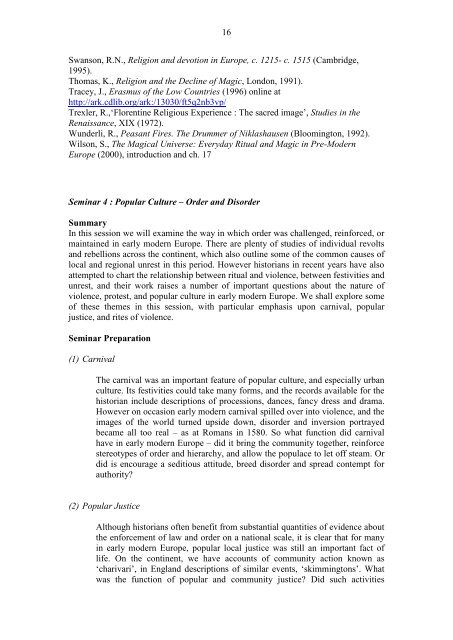Ritual, Myth and Magic in Early Modern Europe - University of Reading
Ritual, Myth and Magic in Early Modern Europe - University of Reading
Ritual, Myth and Magic in Early Modern Europe - University of Reading
Create successful ePaper yourself
Turn your PDF publications into a flip-book with our unique Google optimized e-Paper software.
16<br />
Swanson, R.N., Religion <strong>and</strong> devotion <strong>in</strong> <strong>Europe</strong>, c. 1215- c. 1515 (Cambridge,<br />
1995).<br />
Thomas, K., Religion <strong>and</strong> the Decl<strong>in</strong>e <strong>of</strong> <strong>Magic</strong>, London, 1991).<br />
Tracey, J., Erasmus <strong>of</strong> the Low Countries (1996) onl<strong>in</strong>e at<br />
http://ark.cdlib.org/ark:/13030/ft5q2nb3vp/<br />
Trexler, R.,‗Florent<strong>in</strong>e Religious Experience : The sacred image‘, Studies <strong>in</strong> the<br />
Renaissance, XIX (1972).<br />
Wunderli, R., Peasant Fires. The Drummer <strong>of</strong> Niklashausen (Bloom<strong>in</strong>gton, 1992).<br />
Wilson, S., The <strong>Magic</strong>al Universe: Everyday <strong>Ritual</strong> <strong>and</strong> <strong>Magic</strong> <strong>in</strong> Pre-<strong>Modern</strong><br />
<strong>Europe</strong> (2000), <strong>in</strong>troduction <strong>and</strong> ch. 17<br />
Sem<strong>in</strong>ar 4 : Popular Culture – Order <strong>and</strong> Disorder<br />
Summary<br />
In this session we will exam<strong>in</strong>e the way <strong>in</strong> which order was challenged, re<strong>in</strong>forced, or<br />
ma<strong>in</strong>ta<strong>in</strong>ed <strong>in</strong> early modern <strong>Europe</strong>. There are plenty <strong>of</strong> studies <strong>of</strong> <strong>in</strong>dividual revolts<br />
<strong>and</strong> rebellions across the cont<strong>in</strong>ent, which also outl<strong>in</strong>e some <strong>of</strong> the common causes <strong>of</strong><br />
local <strong>and</strong> regional unrest <strong>in</strong> this period. However historians <strong>in</strong> recent years have also<br />
attempted to chart the relationship between ritual <strong>and</strong> violence, between festivities <strong>and</strong><br />
unrest, <strong>and</strong> their work raises a number <strong>of</strong> important questions about the nature <strong>of</strong><br />
violence, protest, <strong>and</strong> popular culture <strong>in</strong> early modern <strong>Europe</strong>. We shall explore some<br />
<strong>of</strong> these themes <strong>in</strong> this session, with particular emphasis upon carnival, popular<br />
justice, <strong>and</strong> rites <strong>of</strong> violence.<br />
Sem<strong>in</strong>ar Preparation<br />
(1) Carnival<br />
The carnival was an important feature <strong>of</strong> popular culture, <strong>and</strong> especially urban<br />
culture. Its festivities could take many forms, <strong>and</strong> the records available for the<br />
historian <strong>in</strong>clude descriptions <strong>of</strong> processions, dances, fancy dress <strong>and</strong> drama.<br />
However on occasion early modern carnival spilled over <strong>in</strong>to violence, <strong>and</strong> the<br />
images <strong>of</strong> the world turned upside down, disorder <strong>and</strong> <strong>in</strong>version portrayed<br />
became all too real – as at Romans <strong>in</strong> 1580. So what function did carnival<br />
have <strong>in</strong> early modern <strong>Europe</strong> – did it br<strong>in</strong>g the community together, re<strong>in</strong>force<br />
stereotypes <strong>of</strong> order <strong>and</strong> hierarchy, <strong>and</strong> allow the populace to let <strong>of</strong>f steam. Or<br />
did is encourage a seditious attitude, breed disorder <strong>and</strong> spread contempt for<br />
authority?<br />
(2) Popular Justice<br />
Although historians <strong>of</strong>ten benefit from substantial quantities <strong>of</strong> evidence about<br />
the enforcement <strong>of</strong> law <strong>and</strong> order on a national scale, it is clear that for many<br />
<strong>in</strong> early modern <strong>Europe</strong>, popular local justice was still an important fact <strong>of</strong><br />
life. On the cont<strong>in</strong>ent, we have accounts <strong>of</strong> community action known as<br />
‗charivari‘, <strong>in</strong> Engl<strong>and</strong> descriptions <strong>of</strong> similar events, ‗skimm<strong>in</strong>gtons‘. What<br />
was the function <strong>of</strong> popular <strong>and</strong> community justice? Did such activities

















